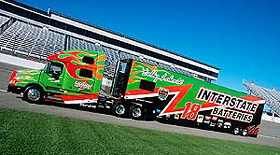Petro In Joplin
Topic 12223 | Page 1
Some of it is just plain being lazy. As far as nosing in the angled spots, some drivers do it because they aren't that difficult to back out of and at that Petro, there's plenty of room to make the cut without fear of hitting something.

Another reason drivers will nose into a parking spot is to get their cab away from a running reefer unit. Some drivers can't stand those things. I myself pulled reefers before my current tanker job and they didn't bother me at all. Always sleep with one of those Tornado Fans running and the truck idling.
Reefer:
A refrigerated trailer.
HOS:
Hours Of Service
HOS refers to the logbook hours of service regulations.
Another reason drivers will nose into a parking spot is to get their cab away from a running reefer unit. Some drivers can't stand those things. I myself pulled reefers before my current tanker job and they didn't bother me at all. Always sleep with one of those Tornado Fans running and the truck idling.
So you're saying that in order to avoid the sound of a reefer, you should replace it with the sound of your own idling truck and a fan that's about 2 steps away from being a jet engine?

Reefer:
A refrigerated trailer.
HOS:
Hours Of Service
HOS refers to the logbook hours of service regulations.The two main reasons for nose-in parking have been discussed here. The big problem is you must have a full, straight in plus more space to line up and pull into the spot. If you have an angle set-up and pull in, when it's time to back out, who will steer the tandems for you?
Later in the night, when all the spots are full and more trucks show up, they will just park anywhere because their time is up. Some truck stops begin to look more like a trucker maze than a parking lot. This is from bad trip planning on their part. Rarely will truck stop operators or even cops go through and shew them away.
Tandems:
Tandem Axles
A set of axles spaced close together, legally defined as more than 40 and less than 96 inches apart by the USDOT. Drivers tend to refer to the tandem axles on their trailer as just "tandems". You might hear a driver say, "I'm 400 pounds overweight on my tandems", referring to his trailer tandems, not his tractor tandems. Tractor tandems are generally just referred to as "drives" which is short for "drive axles".
Tandem:
Tandem Axles
A set of axles spaced close together, legally defined as more than 40 and less than 96 inches apart by the USDOT. Drivers tend to refer to the tandem axles on their trailer as just "tandems". You might hear a driver say, "I'm 400 pounds overweight on my tandems", referring to his trailer tandems, not his tractor tandems. Tractor tandems are generally just referred to as "drives" which is short for "drive axles".

The two main reasons for nose-in parking have been discussed here. The big problem is you must have a full, straight in plus more space to line up and pull into the spot. If you have an angle set-up and pull in, when it's time to back out, who will steer the tandems for you?
Later in the night, when all the spots are full and more trucks show up, they will just park anywhere because their time is up. Some truck stops begin to look more like a trucker maze than a parking lot. This is from bad trip planning on their part. Rarely will truck stop operators or even cops go through and shew them away.
Especially true for the roadside rest stops typical on Pennsylvania Interstates (the ones that require parallel parking)...by midnight they are gridlocked, everything is blocked except for the fortunate few with front-row spots. Trucks parked as if they were "litter". I only use them for 30 minute breaks, that way I can hightail it out before it before they get too congested.
Tandems:
Tandem Axles
A set of axles spaced close together, legally defined as more than 40 and less than 96 inches apart by the USDOT. Drivers tend to refer to the tandem axles on their trailer as just "tandems". You might hear a driver say, "I'm 400 pounds overweight on my tandems", referring to his trailer tandems, not his tractor tandems. Tractor tandems are generally just referred to as "drives" which is short for "drive axles".
Tandem:
Tandem Axles
A set of axles spaced close together, legally defined as more than 40 and less than 96 inches apart by the USDOT. Drivers tend to refer to the tandem axles on their trailer as just "tandems". You might hear a driver say, "I'm 400 pounds overweight on my tandems", referring to his trailer tandems, not his tractor tandems. Tractor tandems are generally just referred to as "drives" which is short for "drive axles".
Interstate:
Commercial trade, business, movement of goods or money, or transportation from one state to another, regulated by the Federal Department Of Transportation (DOT).
The two main reasons for nose-in parking have been discussed here. The big problem is you must have a full, straight in plus more space to line up and pull into the spot. If you have an angle set-up and pull in, when it's time to back out, who will steer the tandems for you?
Later in the night, when all the spots are full and more trucks show up, they will just park anywhere because their time is up. Some truck stops begin to look more like a trucker maze than a parking lot. This is from bad trip planning on their part. Rarely will truck stop operators or even cops go through and shew them away.
Especially true for the roadside rest stops typical on Pennsylvania Interstates (the ones that require parallel parking)...by midnight they are gridlocked, everything is blocked except for the fortunate few with front-row spots. Trucks parked as if they were "litter". I only use them for 30 minute breaks, that way I can hightail it out before it before they get too congested.
I laugh when they get so crowded that you see guys parking on the car side. I try to avoid them even for a 30, I'll take the next exit and sit on the on ramp first.
Tandems:
Tandem Axles
A set of axles spaced close together, legally defined as more than 40 and less than 96 inches apart by the USDOT. Drivers tend to refer to the tandem axles on their trailer as just "tandems". You might hear a driver say, "I'm 400 pounds overweight on my tandems", referring to his trailer tandems, not his tractor tandems. Tractor tandems are generally just referred to as "drives" which is short for "drive axles".
Tandem:
Tandem Axles
A set of axles spaced close together, legally defined as more than 40 and less than 96 inches apart by the USDOT. Drivers tend to refer to the tandem axles on their trailer as just "tandems". You might hear a driver say, "I'm 400 pounds overweight on my tandems", referring to his trailer tandems, not his tractor tandems. Tractor tandems are generally just referred to as "drives" which is short for "drive axles".
Interstate:
Commercial trade, business, movement of goods or money, or transportation from one state to another, regulated by the Federal Department Of Transportation (DOT).
G-Town says:
Especially true for the roadside rest stops typical on Pennsylvania Interstates (the ones that require parallel parking)...by midnight they are gridlocked, everything is blocked except for the fortunate few with front-row spots. Trucks parked as if they were "litter". I only use them for 30 minute breaks, that way I can hightail it out before it before they get too congested.
A while ago, I found an official document that basically covered the history of truck parking on interstates. The original truck parking areas were like those G-town describes - parallel spots for trucks. The document points out truckers hated the idea. Later more stops were built with the better pull through layout.
I can't remember where that document is posted, but it's an official US government document.
Interstate:
Commercial trade, business, movement of goods or money, or transportation from one state to another, regulated by the Federal Department Of Transportation (DOT).
HOS:
Hours Of Service
HOS refers to the logbook hours of service regulations.
Another reason some drivers park nose in is to protect their tractor from an accident. Which do you think is gonna cost more to repair and be a bigger problem... the front of your tractor... which has all those expensive engine parts... or the trailer which is just sheet metal, botls nuts and screws n stuff... ok axles and tires too but those prob won't be damaged as bad. Mostly a concern for lease and o/o but even as a company driver I would not be happy if my means of making money got damaged, the trailer can be replaced for much less. Also you might still be able to drive if the trailer gets hit... the truck... not as likely.
so some might do it to get away from reefer noise, other's are lazy and then the 3rd are those trying to protect their tractor. The last one also is a reason why some people park as far away from the services as they can, most rookie drivers (heck even I might at first) will want to be close to things like the bathrooms, showers, food, etc so they want those close spots but more experienced might value the tractor more so they park far away to reduce the risk of being hit.
Reefer:
A refrigerated trailer.
HOS:
Hours Of Service
HOS refers to the logbook hours of service regulations.New Reply:
New! Check out our help videos for a better understanding of our forum features

















Preview:









 TT On Facebook
TT On Facebook
So Tuesday will mark my first full week solo, since being upgraded after training. My backing is getting better. Although, I did have a little trouble getting into the angled parking spot last night, however, another driver helped by spotting me. I noticed a lot of trucks, at least 1/4-1/3 of all trucks went nose in. Some drivers even went as far as to create there own parking spaces, to avoid backing into a spot, even though there was plenty of spaces available. Why is that ?